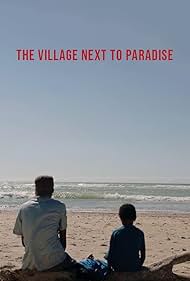A newly formed family faces challenges as they pursue individual goals and face the challenges of modern life, relying on love, trust, and resilience to guide them. Along a deserted beach in the wind and waves, father and son, Mamargade and Seagal, enjoy a little happiness in nature. Such cherished moments are rare and far from the numerous jobs, drone strikes that bring death from above, checkpoints and work payments that take months, if ever, to materialize. In their simple and tiny house made of cinder blocks and corrugated steel, the couple lives with their sister Mamargada Oravilo. Seagal’s dreams of the world. Oravilo dreams of sewing and selling her own clothes. As an unmarried woman, she cannot get a loan, so Oravilo hatches a plan to circumvent the regulation. The risks are huge. “All my life I’ve been trying to make everything better,” says Mamorgade, “but I keep making mistakes.” When misfortune overshadows almost every aspect of everyday life, it is impossible to avoid “mistakes”. However, the modest and hardworking trio never stops asking and hoping for luck, their own business, time at the beach, school funding and better days. “A Village Near Paradise” was first released in Cannes. “This is the first film shot on location in Somalia,” said director Mo Harawe, who attended the North American premiere at the Toronto International Film Festival. Harave collaborated with the Paradise community to make the film and hired non-professional actors. The investment in Somalia paid off in terms of the film’s authenticity. The ambient sound of music on the radio, road traffic, waves and wind also contributed to the realism. “The wind is a character,” Harave said, “that’s why human characters are never alone.” Culture is also a character, and I liked the immersion in Somali songs, stories and landscape.
- ابزار برقی
- ابزار شارژی
- دریل و پیچ گوشتی
دریل و پیچ گوشتی
دریل شارژی
پیچ گوشتی شارژی
دریل بتن کن شارژی
آچار بکس شارژی
- فرز شارژی
مینی فرز شارژی
سایر فرزهای شارژی
- اره شارژی
اره همه کاره و افقی بر شارژی
اره عمودبر شارژی
اره گردبر شارژی
اره زنجیری شارژی
قیچی باغبانی شارژی
- بلوور (دمنده و مکنده) شارژی
دمنده و مکنده شارژی
جارو شارژی
- سایر محصولات شارژی
کارواش شارژی
پمپ باد شارژی
شیشه پاک کن شارژی
رنگپاش شارژی (پیستوله)
منگنه کوب شارژی
میخ کوب شارژی
چراغ قوه شارژی
علف زن شارژی
باطری و شارژر
- دریل و پیچ گوشتی
- ابزار بادی
- بکس بادی
بکس بادی درایو “1
بکس بادی درایو “1/2
بکس بادی درایو “1/2-1
بکس بادی درایو “3/4
بکس بادی درایو “3/8
جغجغه بادی
- دریل و پیچ گوشتی بادی
دریل بادی
پیچ گوشتی بادی
بتن کن بادی
- میخکوب و منگنه کوب
منگنه کوب
میخکوب
- پمپ باد
کمپرسور باد 5 تا 80 لیتری
کمپرسور باد 100 تا 1200 لیتری
کمپرسور فندکی
- بکس بادی
- ابزار باغبانی
- اره باغبانی
اره زنجیری برقی
اره زنجیری بنزینی
اره هیزم بری
اره باغبانی
- چمن زن و علف زن
چمن زن برقی
چمن زن بنزینی
علف زن موتوری
علف زن برقی
شمشاد زن
علف زن شارژی
- سایر محصولات باغبانی
برگ جمع کن بنزینی
برگ جمع کن برقی
قیچی باغبانی
- اره باغبانی
- ابزار نجاری
- فارسی بر
اره فارسی بر
اره میزی
فارسی بر دوکاره
پایه فارسی بر
- اره نجاری
اره عمود بر
اره گرد بر
اره فلکه ای
اره مویی برقی
اره افقی بر / همه کاره
اره سوسماری
اره گرد نفوذی
- دستگاه سنباده زن
پولیش برقی
سنباده لرزان تخت
سنباده لرزان مشتی
سنباده لرزان گرد
سنباده نواری
سنباده دیسکی
سنباده تانکی
- دستگاه فرز نجاری
اور فرز - فرز نجاری
فرز مشتی نجاری
فرز بیسکویت زن
فرز دم چلچله زن
- منگنه و میخکوب
منگنه کوب بادی
میخکوب بادی
- تیغ اره
تیغ اور فرز و CNC
تیغ اره الماسه
تیغ اره عمودبر
تیغه اره مویی
تیغ اره افقی بر
- فارسی بر
- ابزار اندازه گیری
- تراز
تراز لیزری
تراز دستی
تراز 360 درجه
تراز اپتیک (تراز یاب)
تراز چرخشی
- متر
متر لیزری
متر دستی
میکرومتر
کولیس
خط کش
- سایر ابزارهای اندازه گیری
درجه باد
مانومتر
گونیا
دماسنج
رطوبت سنج
- تراز
- ابزار دستی
- انبر
انبر قفلی
انبردست
دم باریک
سیم چین
سیم لخت کن
انبر آرماتور
انبر کلاغی
انبر پرچ
خار باز کن و خار جمع کن
- قیچی
قیچی لوله بر
قیچی ورق بر
قیچی مفتول بر
قیچی باغبانی
- چکش و تبر
چکش و پتک
تبر
- آچار
آچار فرانسه
آچار تخت و رینگی
آچار شلاقی
آچار لوله گیر
آچار جغجغهای
آچار آلن و ستاره ای
- سایر محصولات دستی1
کاتر
رنده کناف
ست ابزار
جعبه بکس
گیره رومیزی
پیچ گوشتی
سوهان
منگنه کوب دستی
فازمتر
تلمبه
سنبه
قلم مو
الماس شیشه بر
پرس کابلشو
- سایر محصولات دستی2
اتو لوله سبز
پیچ دستی نجاری
ابزار های چند کاره
کمان اره
روغن دان
گونیا دستی
مغار نجاری
ست ابزار خانگی
سوهان آهن و چوب
کاردک
چاقو تیز کن
ابزارهای عمومی
- انبر
- ابزار جانبی
- لوازم جانبی جوش و برش
انبر جوش
انبر اتصال
الکترود جوشکاری
نازل برش
سرپیک جوش و برش
کابل جوشکاری
شلنگ جوشکاری
- متعلقات ابزار جانبی
باطری و شارژر
میخ و چاشنی
لوازم جانبی فرز مینیاتوری
ست مته و سر پیچ گوشتی
پد پولیش
شلنگ فنری
کوپلینگ باد
تبدیل و آچار سه نظام
لقمه اتو لوله
جعبه ابزار
کیف ابزار
فیلتر هوا کمپرسور
- لوازم جانبی جوش و برش
- مته گردبر قلم
- تیغه برش و ساب
- صفحه فرز و پالیش
صفحه برش سنگ
صفحه برش آهن و استیل
صفحه برش چوب
گرانیت بر
پد صفحه سنباده
سرامیک بر
فرچه سیمی
پرسلان بر
صفحه پروفیل بر
صفحه فارسی بر
صفحه سنباده
سنباده پشت کرکی
سنگ سنباده
- تیغ اره
تیغ اره افقی بر
تیغ اور فرز و CNC
تیغ اره ام دی اف بر
تیغ اره الماسه
تیغ اره عمودبر
تیغه اره مویی
تیغ اره چوب بر
- صفحه فرز و پالیش
- موتور برق (ژنراتور)







